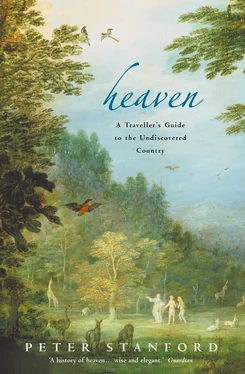1 ...8 9 10 12 13 14 ...18 He first arrives at the lake Ara. He crosses it with his mind, but those who go into it without complete knowledge drown in it. Then he arrives near the watchmen, Muhurta, but they flee from him. Then he arrives at the river Vijara, which he crosses with just his mind. There he shakes off his good and bad deeds, which fall upon his relatives – the good deeds upon the ones he likes and the bad deeds upon the ones he dislikes. It is like this – as a man driving a chariot would look down and observe the two wheels of his chariot, so he looks down and observes the days and nights, the good and bad deeds, and all the pairs of opposites. Freed from his good and bad deeds, this man, who has knowledge of brahman, goes on to brahman.
( Upanishads , translated by Patrick Olivelle)
Brahman, the divine soul anthropomorphised and sitting on a couch that is described as ‘life breath’, with one leg each for past, present, prosperity and nourishment, asks the new arrival to identify him or herself:
I am the season. I am the offspring of the season. I was born from the womb of space as the semen for the wife, as the radiance of the year, as the self [atman] of every being. You are the self of every being. I am who you are … the real.
The system of reincarnation and karma was closely linked in the Upanishads with earthly developments, notably the institutionalisation of the caste system in around 500 BC. Your karma was measurable by what class you belonged to on earth. It was difficult, therefore, within any one life-time to rise through the ranks. Hence the Brahmins (or priestly caste) were acknowledged as enjoying good karma accumulated in previous lives, while the Shudras (or servant caste) were suffering as a result of past bad karma. Ultimately, it made for an enclosed and hopeless world-view, effectively shutting off the possibility of developing and growing within a life and rising above your circumstances.
In so far as they were seen to buttress the existing political order by giving it a divine stamp of approval, the Upanishads came under attack. Moreover, because they taught that reaching the point of absorption into the Great Self was extremely rare, and that, even when achieved, it was a divine status that could easily be lost, with the consequent return to death and rebirth, their core message became, for many, a depressing and pessimistic one. Samara was part of an eternal grind of Sisyphean proportions.
Two movements arose simultaneously to challenge this bleak prospect. Mahavira (c. 540–468 BC), the most revered figure among the Jains, and Siddhartha Gautama Buddha (c. 563-c. 483) both suggested that karma should be seen as an exclusively spiritual quality which could not be directed to the practical end of propping up the caste system: no matter what level of society you were born into, you could still be a good spirit and grow and develop towards the ultimate within yourself inside that one lifetime. Mahavira advocated an asceticism, which included veganism, nudity and celibacy, and nonviolence towards all living creatures as the key to salvation from the cycles of reincarnation. His was a rigorous self-help credo, placing as a realisable goal liberation from the flesh and the world into a realm of mental and spiritual bliss called Isatpragbhara or Kevala at the top of the universe.
Jainism was a fundamentalist version of mainstream Hinduism and continues to thrive today with around two million adherents. Much more widespread, however, are the 350 million Buddhists worldwide (though very few are now in India itself). Buddhism took a gentler, less extreme course. Siddhartha Gautama was born in the sixth century BC, the son of a king in the foothills of the Himalayas in the north of India. His legend tells that when he was a young man he married, but he was afflicted by a strange malaise. He abandoned his prosperous family and his life of pleasure and indulgence, embarking instead on fasting, asceticism and meditation on sacred texts, finally achieving release from earthly desires and suffering under a Bodhi tree in his Great Enlightenment. Life on earth could be miserable, he taught, and each must seek liberation in this life, not by the self-denial of the Jains, or the resignation of the Upanishads, but rather by searching after knowledge of spiritual truths. There were, he said, Four Noble Truths which demonstrated that misery was caused by craving which in its turn could be cured by means of the Noble Eightfold Path. This led to the breaking of samsara and, ultimately, to nirvana – a mental state of blessedness. The eight steps on the path concerned growing in understanding and spiritual wisdom, living a moral life, and cultivating the mental discipline to prepare for nirvana. In Sanskrit, the word nirvana means ‘extinguished’ and for Buddha – the ‘enlightened one’ – it was a place for the extinguishing of human misery and cravings by self-knowledge.
While Buddha accepted the cycle of reincarnation and karma taught by the Upanishads, he offered as a release from samsara an achievable nirvana. Part of that nirvana was the knowledge of a deity, but, unlike Judaism, Buddha focused not on a personal god but on individual and internal enlightenment. This could, Buddha warned, be a long time coming. One of the most popular books in Buddhism is the Jatakas – birth-stories – which contains some 550 accounts of previous births of the Buddha in various human and animal forms.
Nirvana was not supernatural. ‘He did not rely,’ writes his biographer, the distinguished religious historian, Karen Armstrong, ‘on divine aid from another world, but was convinced that nirvana was a state that was entirely natural to human beings and could be experienced by any genuine seeker. Gautama believed that he could find the freedom he sought right in the midst of this imperfect world. Instead of waiting for a message from the gods, he would search within himself for the answer, explore the furthest reaches of his mind and exploit all his physical resources.’
From the third century BC, Buddhism began to spread, notably to China. Legend tells that in the first century BC a Han emperor sent envoys along the Silk Route to India. They returned with written versions of Siddhartha Gautama’s teachings which so impressed their readers that Buddhism immediately took root in China. The truth is more complex. Whereas in other parts of southeast Asia Buddhism had quickly and easily assimilated with existing beliefs, in China it stood in stark contrast to the two dominant ideologies, Confucianism and Taoism, both much more perfunctory in their attitude to the afterlife and transcendence. There was, therefore, a clear choice and a long period of conflict and competition.
Confucianism was a decidedly worldly creed which discouraged any great emphasis on either the hereafter or the mystical, and promoted instead practical imperatives on social responsibility, collective action, family values and hard work. Confucius (551–479 BC) was the codifier of an existing but ill-defined system of natural justice, someone who took received wisdom and moulded it in a robust package of beliefs. He was notably inhospitable to any supernatural concepts, but he did appeal to the individual to develop their intellectual powers and to act fairly in terms of following ‘the way of heaven’. This led all, whether high-born or low-born, ultimately to the reward of Tian, a paradise for virtuous souls governed by a ‘supreme spiritual presence’. This supreme being was later to be confused by Confucians with the person of the Emperor of China, in an effort to shore up political authority, but it was an understandable mistake for Confucius had great respect for the instruments of government (though he did not regard rulers as divine per se). The supreme spiritual being was ill-defined and vague, certainly not a Western-style god of judgement, and a force seldom active on earth.
Читать дальше












